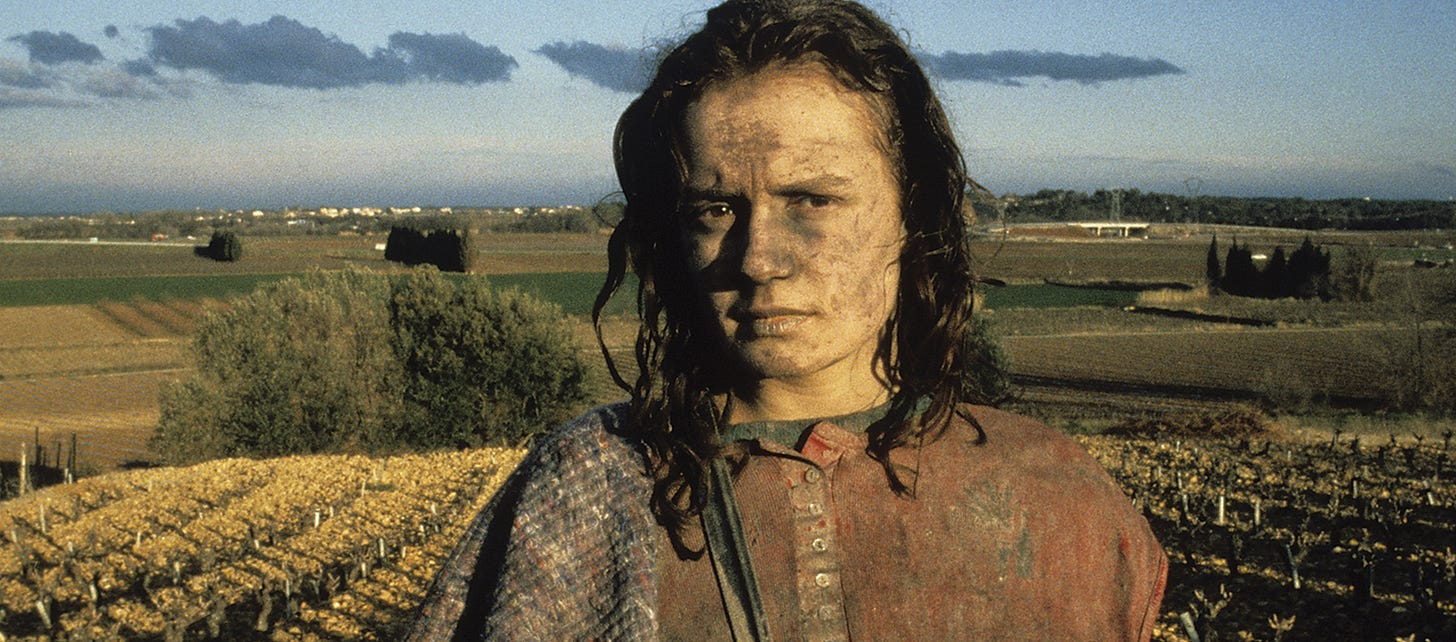Vagabond begins and ends on a shot of a young woman lying dead in a ditch in the chilly South of France sometime in the 1980s. Since she is fully clothed and uninjured, the film immediately eliminates suspicions of foul play, but subtly hints at an even more sombre explanation for the girl’s untimely demise. Though the authorities cannot identify her, we soon learn that her name is Mona (played by Sandrine Bonnaire) and that the final wintry months of her life were spent hitchhiking and drifting through rural France. With little else known about Mona, those who encountered her on this journey tell her story through documentary-like interviews and flashbacks. What we can glean about the enigmatic protagonist is therefore shaped by her interactions with these other characters – her non-conformist resourcefulness and deviant behaviour is highlighted in contrast to their object permanence. The French title of the movie, Sans toit nil oi, translates in English to “without roof or rule”; a play on the French expression, “sans foi ni loi” meaning “without faith or law”. Mona drifts in and out of the lives of those who are identified by their place within an overt social structure and in doing so, defines herself by her rejection of a fixed identity.
There’s a distinct aesthetic appeal to films made in the 1980s. Wedged between the glossier glamour of the ‘70s and the ‘90s, ‘80s media has always spoken to me with its bad haircuts, shapeless clothing and muted tones. I mean the latter in every sense – it feels as though many of the movies of the 1980s are clouded by grey skies. It says something bigger about the austerity, depression and rebellion unique to this decade. It coats stories of the downtrodden in society in a certain grit that lies in the DNA of the time. Varda’s shots are of course very beautiful, and she is not impervious to this grit; she actually invokes it in the climate, costumes and tones of the film to unravel Mona’s futile plight.
We see Mona join forces with another male drifter in an abandoned château. The house is both extravagant and derelict, donned in regal paintings and antiques almost obliterated by dust. The pair are absorbed in an impoverished but jubilant romance – smoking weed, eating canned food, making love and playing house somewhere they can never call home. The lovers blast up-beat rock music through the château, which comes in stark contrast to the orchestral scoring that follows Mona throughout the rest of the film. This is really the only chapter in Vagabond where we are able to bask in the joys of youthful delinquency, and we are not the only ones. Yolande, a maid whose uncle works as a caretaker in the château, comes across the pair sleeping peacefully in the fantasy they’ve built for themselves. Leaving them undisturbed, Yolande admires their nomadic romance and yearns for a life as exciting as theirs. But as we learn, every place Mona takes shelter is only a temporary refuge, and she is eventually forced to leave. Yolande and Mona will meet again – under different circumstances, in a budding friendship – until Yolande abruptly casts her aside when her boyfriend takes a liking to Mona.
This is virtually how all of Mona’s relationships end – with her hosts, who initially take a liking to her, feeling her unconventional lifestyle encroaching on the parameters of their own sense of security and in turn, denying her of any. We see Mona take refuge on a farm run by a retired philosopher who gives her a patch of land she has no intention of cultivating. Incensed by her lack of work ethic, he kicks her out as she swiftly finds herself back on the streets and in the throes of charity from another academic. The glamorous female professor gleefully drives Mona from place to place as they eat and laugh together. As the two women are seated at a roadside diner, Varda closes in on both pairs of hands resting at the table across from one another. The professor’s fingers are glowing – her manicured nails bathed in glossy red polish – feeding poor Mona’s soiled hands that we can practically smell from this image. The professor sees Mona as something of a pet to show off to her friends – finding charm in her unbathed, chain-smoking stench – though only fleetingly until she decides she’s had her fun and sends Mona on her way yet again.
Don’t be fooled – Mona is foul-mouthed, rude and relentlessly stubborn. But she has an acute understanding of how to get what she needs from others by playing into their fantasies of adventure and charity. When all is said and done, she starts again, struggling through the discomfort of the icy woods in search of her next refuge, steadfast in her choices and never once inviting pity. She drifts in and out of lives bound by a fixed address and a role to fulfill in the social ecosystem. Vagabond invites us to scrutinise our own relationships and life choices, even prompting an uncomfortable reckoning with the Faustian bargains we ourselves have made to instil a sense of security in our lives. Mona exists outside the boundaries most people set for themselves, defined solely on what she is not. Surrendering herself to this existence, Mona freezes to death, alone in the woods; a martyr for the wayward path she has taken. When we first see her frozen corpse, the film cuts to a voiceover from Varda herself, breaking the fourth wall of storytelling in a prologue:
“No one claimed the body. She had died a natural death without leaving a trace. But people she had met recently remembered her. Those witnesses helped me tell of the last weeks of her last winter. She left her mark on them… I know little about her myself, but it seems to me that she came from the sea.”


